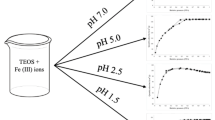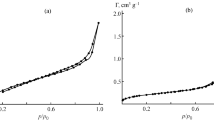Abstract
Highly dispersed silica samples with different degrees of substitution of silanol groups by trimethylsilyl groups are obtained by the gas-phase modification method. The adsorption of vitamins B1, B6, and E on initial and modified silica samples is studied. It is shown that the modified adsorbents with degrees of substitution of silanol groups up to 40% exhibit higher affinity to vitamin molecules; in this case, adsorption properties of the modified silica samples depend on the nature of the adsorbate and the number of grafted groups.
Similar content being viewed by others
References
Medical Chemistry and Clinical Application of Silicon Dioxide, Ed. by A. A. Chuiko (Naukova Dumka, Kiev, 2003) [in Russian].
A. A. Chuiko and Yu. I. Gorlov, Chemistry of Silica Surface: Structure of Surface, Active Centers, Mechanisms of Sorption (Naukova Dumka, Kiev, 1992) [in Russian].
L. V. Lysenko, V. I. Chueshov, and T. T. Lavrushina, Farmatseya 26(1), 56 (1977).
B. Fubini and W. E. Wallace, in Adsorption on Silica Surface, Ed. by E. Papirer (M. Dekker, New York, 2000), pp. 646–663.
V. Castranova and V. Vallyathan, Environ. Health Perspect. 108(4), 675 (2000).
S. V. Pakhovchishin, A. K. Matkovskii, G. R. Yurchenko, et al., Dokl. NAN Ukrainy, No. 9, 144 (2001).
P. A. Kuzema and I. V. Laguta, in Proceedings of the 11th International Scientific-Methodological Conference “Technologies of XXI Century” (Alushta, 2004), pp. 49–54 [in Russian].
Yu. G. Frolov, A Course of Colloid Chemistry: Surface Phenomena and Dispersed Systems: Textbook for High School (Khimiya, Moscow, 1982) [in Russian].
N. N. Vlasova, N. K. Davidenko, N. M. Shevchenko, et al., Ukr. Khim. Zh. 57, 1277 (1991).
A. A. Svezhentsova, N. K. Davidenko, N. N. Vlasova, and V. I. Bogomaz, Zh. Fiz. Khim. 67, 1242 (1993).
V. A. Bidzilya, L. P. Golovkova, N. N. Vlasova, et al., Ukr. Khim. Zh. 60(9), 616 (1994).
Author information
Authors and Affiliations
Additional information
Original Russian Text © O.N. Stavinskaya, I.V. Laguta, P.A. Kuzema, 2006, published in Zhurnal Fizicheskoi Khimii, 2006, Vol. 80, No. 8, pp. 1482–1485.
Rights and permissions
About this article
Cite this article
Stavinskaya, O.N., Laguta, I.V. & Kuzema, P.A. Adsorption properties of highly dispersed silica with a partially hydrophobic surface. Russ. J. Phys. Chem. 80, 1305–1308 (2006). https://doi.org/10.1134/S0036024406080243
Received:
Issue Date:
DOI: https://doi.org/10.1134/S0036024406080243




